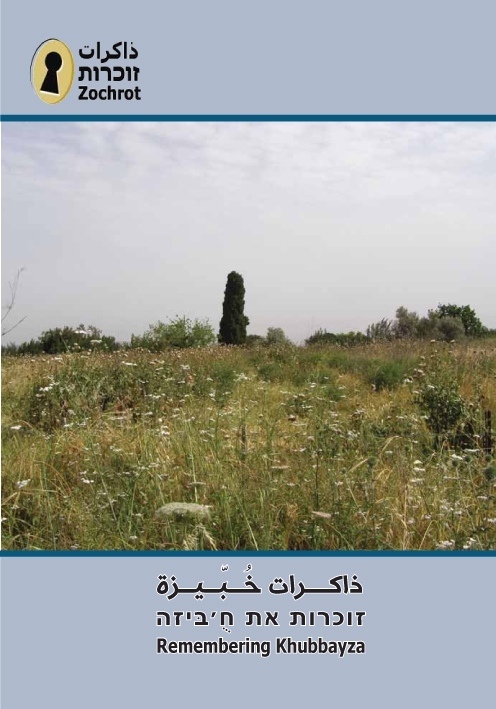Excerpt from the booklet:
Kubbazya
A Palestinian village located forty kilometers south of Haifa, on the main road from the coast to the Ibn 'Amir valley (the Jezre'el Valley), about sixteen kilometers from the Mediterranean shore. The village was built 175 meters above sea level on a gently sloping hill on the southern ridge of Mt. Hajwa, a part of the Carmel range. Wadi al-'Arayyis , the upper portion of Wadi al-Sindiyana, passes about one kilometer north of the village. The residents of the village also called it al-Wadi al-Shamali (the northern wadi), apparently because of its location in relation to the village. There were a number of springs and wells on village lands which provided villagers with drinking water, water for their animals and for irrigating their crops. These included 'Ayn al-Nab'a ("the flowing spring") north of the village, 'Ayn al-'Asal ("the honey spring") to the northeast, the Muhammad well to the south, the Hajwa well to the southeast and al-'Ayn al- Gharbiyya (the western spring) southwest of the village.
The village was named for the green, broadleaved khubbayza plant which grows wild and is used for food and for its medicinal properties. In 1948, the village contained 67 structures, standing close together on an area of eleven dunums. Most were built of stone. At that time, about 335 people lived in the village; at the end of the 19th century its population was 270 persons. The villagers were farmers, raised cattle and sheep and worked their land. They had 2828 dunums of land - about 2295 dunums planted with various types of pulses, 65 dunums of vegetables, 20 dunums of olives trees and about 460 dunums lay fallow.
The village today
All of Khubbayza's buildings were completely demolished and the village erased from the face of the earth. Today the center of the village is surrounded by a barbed wire fence and the stones of the buildings Israel destroyed are scattered on the ground, but it is difficult to see the remains and walk among them because of the dense, tall wild vegetation and thorns covering the area. A few pomegranate, fig and mulberry trees that had been planted among the village buildings are still growing on the village land that is enclosed on two sides by a fence of wild vegetation. Khubbayza's cemetery, on the other had, is clean and clearly visible, maintained by Palestinian organizations from the Umm al- Fahm area. Kibbutz Gal'ed (which changed its name to Even Yitzhak) uses Khubbayza's lands. It cultivates some of them and uses others for grazing cattle. Kibbutz Gal'ed was established in 1945, one kilometer from Khubbayza, on land that had been purchased from the village of al-Butaymat . Nothing is known about any conflicts or tensions that may have existed between Khubbayza and Gal'ed. A tel, known as al-Kalba (the dog) or al-Kalbi , named for the Arab Bani Kalb tribe and containing ancient relics, adjoined the village.
Prior to the nakba there were a number of Palestinian villages near Khubbayza, including al-Kafrayn and al-Butaymat to the east, Sabbarin, Umm al-Shuf and Daliyat al-Rawha, al-Sindiyana to the north and Kufr Kar'a to the south. All these villages were captured in 1948 and completely destroyed by Israel, except for Kufr Kar'a, which still exists.
The capture of Khubbayza
The village was captured by the Etzel between May 12-14, 1948, after the battle of Mishmar Ha'Emeq. On May 4, irregular Arab forces, commanded by Fawzi al-Qawuqji (the Arab Liberation Army) attacked kibbutz Mishmar Ha'Emeq to disrupt attacks by the Haganah on Palestinian localities in other sectors, particularly in the Haifa area. The kibbutz was located between the villages of Abu Zurayq, Abu Shusha and al-Ghubayyat. At the battle's outset, Arab Liberation Army forces had an advantage over the Haganah forces in the kibbutz, but the Haganah, implementing "Plan Dalet," then attacked the Palestinian villages. Benny Morris, in The Birth of the Palestine Refugee Problem 1947-1949, notes that this was the first time that Ben Gurion explicitly approved the expulsion of Arabs from an entire region. The Haganah first attacked al-Ghubayyat and Bayt Ras, then Abu Shusha , al- Kafrayn , Abu Zurayq and al-Mansi. The conquest of these village was savage – the inhabitants were expelled, their homes blown up to prevent their return, there was looting and murder of unarmed prisoners and villagers. These events even led to an argument within Jewish society at that time over the Haganah's savage behavior toward the civilian Palestinian population. Fearful as a result of these attacks as well as because of the defeat of the Arab Liberation Army, news of the Dayr Yassin massacre and the death of 'Abd al-Qadir al Hussayni at al- Qastal, outside of Jerusalem, the inhabitants of al-Butaymat , the village adjoining Khubbayza, left to seek safety. Etzel forces in Hadera, Zichron Ya'akov, Binyamina and Netanya completed an encirclement that supplemented the Haganah's attack and on May 12, under a barrage of mortar fire, attacked the villages remaining in the Ramot Menashe (al-Rawha) area, west of Mishmar HaEmeq, and expelled their inhabitants: Sabbarin ,al-Sindiyana , al-Burayka ,Khubbayza and Umm al- Shuf. The attacking forces combed the villages, gathered residents who had remained behind barbed wire fences and later expelled them to the region of Jenin and Umm al- Fahm.
Download File



